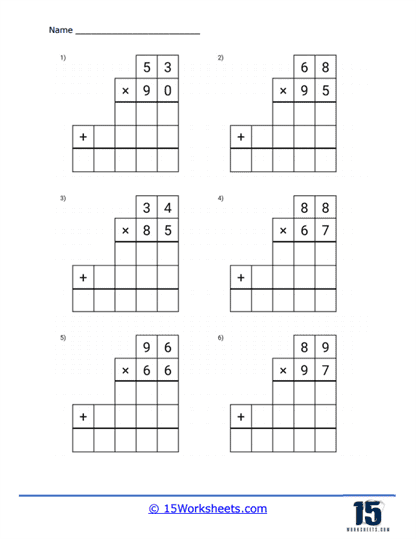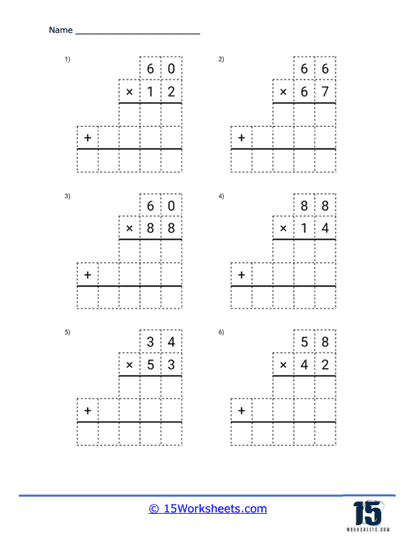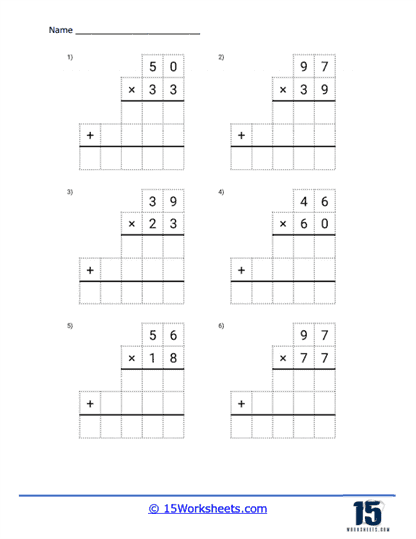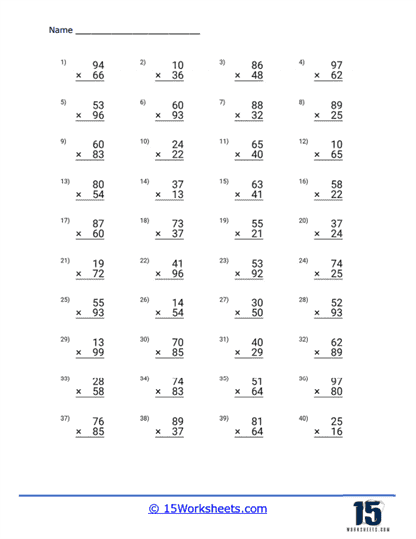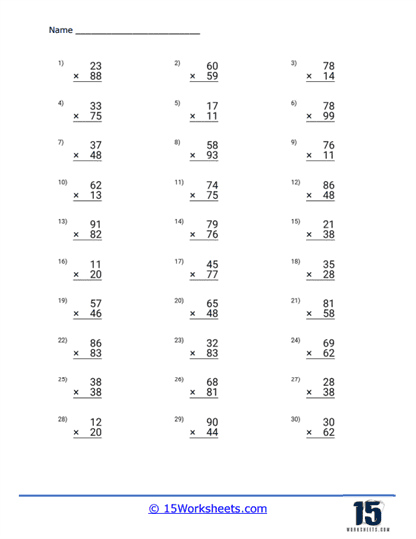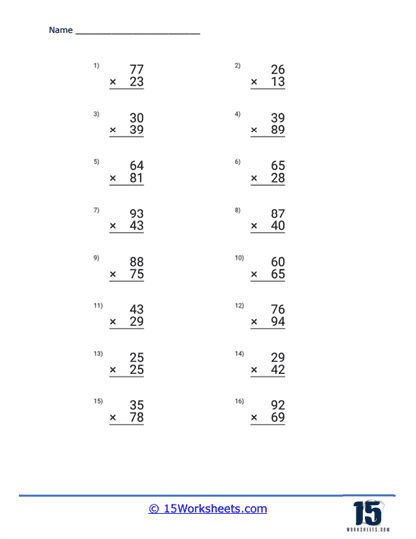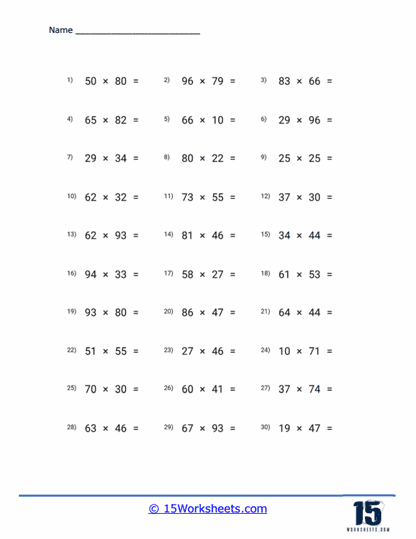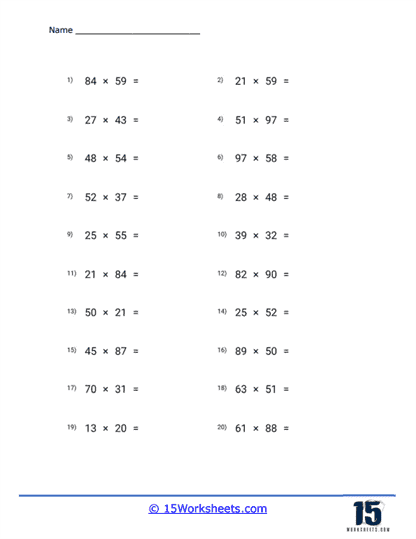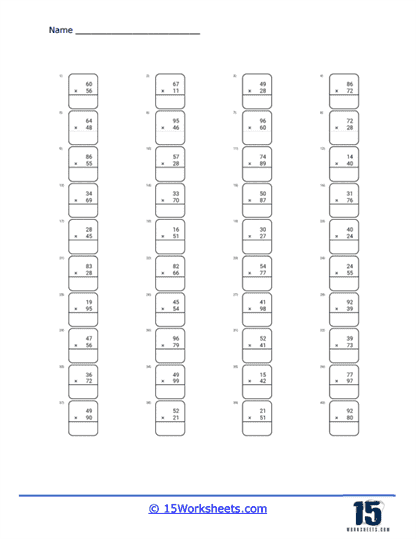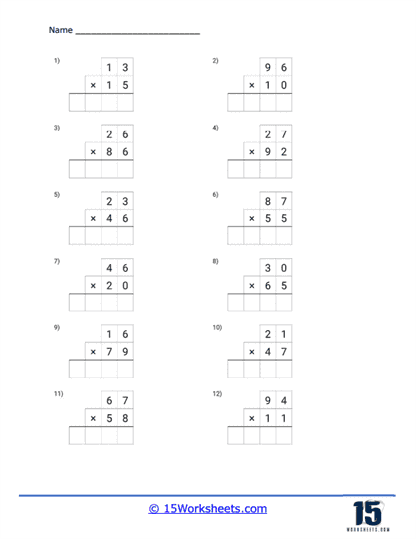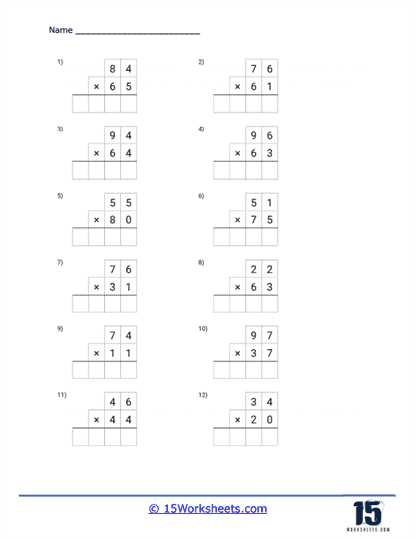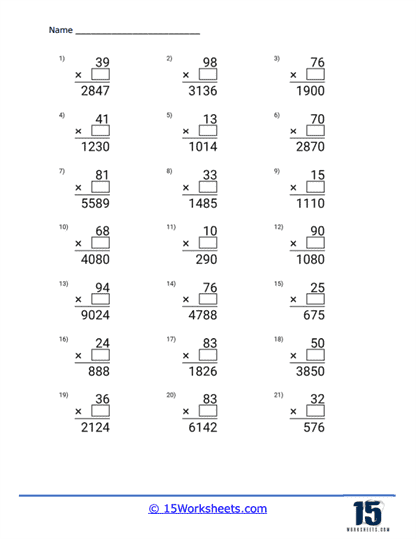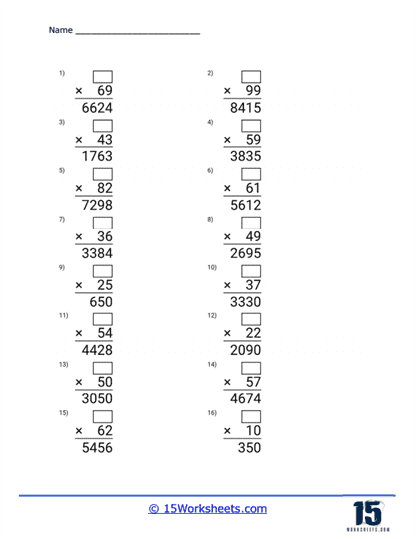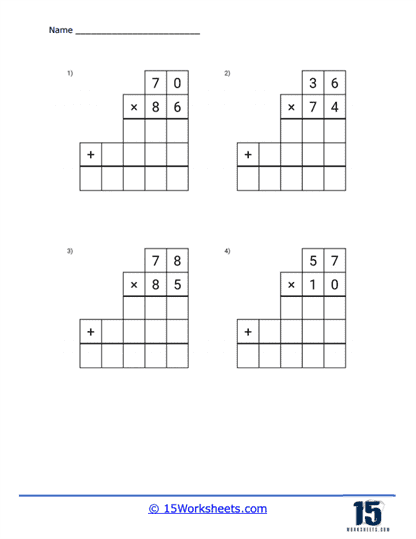2 digit by 2 digit Multiplication Worksheets
About These 15 Worksheets
These free worksheets are helpful for tutors and teachers to teach elementary students the essential skill of multiplying two-digit numbers. These worksheets offer numerous benefits that foster mathematical proficiency, critical thinking, and problem-solving skills.
What Do They Work On?
Reinforce Multiplication Concepts – 2-digit by 2-digit multiplication worksheets provide students with structured practice opportunities to reinforce their understanding of multiplication concepts. By repeatedly applying these concepts to solve problems, students solidify their knowledge of place value, regrouping, and the relationship between digits in multiplication.
Develop Mental Math Skills – Working through 2-digit by 2-digit multiplication problems helps students develop mental math strategies. As they progress through the worksheets, students become more proficient in mentally computing products and estimating their answers, fostering computational fluency and mental agility.
Strengthen Problem-Solving Skills – Multiplication worksheets often include word problems that require students to apply their multiplication skills in real-life contexts. By solving these problems, students enhance their problem-solving abilities, critical thinking skills, and their capacity to apply mathematical concepts to practical situations.
Promote Mathematical Confidence – Regular practice with 2-digit by 2-digit multiplication worksheets helps build students’ confidence in their mathematical abilities. As they master this skill, students gain a sense of accomplishment and become more self-assured in their mathematical capabilities, encouraging further engagement and success in math.
Enhance Number Sense – 2-digit by 2-digit multiplication worksheets improve students’ number sense by exposing them to larger numbers and the patterns and relationships within them. By working with two-digit numbers, students develop a deeper understanding of place value and the magnitude of numbers.
Increase Math Fluency – Regular practice with 2-digit by 2-digit multiplication worksheets improves students’ multiplication fluency. By gradually increasing the complexity of the problems, students build speed and accuracy in their calculations, facilitating quicker mental math and problem-solving abilities.
Develop Critical Thinking Skills – Multiplication worksheets require students to think critically and strategically to solve problems efficiently. By utilizing various strategies, such as regrouping, partial products, or the standard algorithm, students develop critical thinking skills and the ability to choose appropriate methods for different types of multiplication problems.
Individualized Learning – Worksheets can be adapted to cater to individual students’ needs, allowing for differentiated instruction. Educators can adjust the complexity and difficulty level of problems based on each student’s skill level, providing appropriate challenges or additional support as necessary.
Preparation for Advanced Math Concepts – Proficiency in 2-digit by 2-digit multiplication lays the foundation for more complex mathematical concepts and operations, such as long division, algebraic equations, and higher-level problem-solving. Mastering this skill equips students with the necessary computational skills to tackle advanced math topics in middle and high school.
What Types of Exercises Can You Expect On These Worksheets?
Vertical Multiplication – Students multiply two-digit numbers using the vertical format, following the standard algorithm. This format emphasizes place value and the step-by-step process of multiplying each digit.
Partial Products Method – Students break down the multiplication process into smaller parts, multiplying the tens and ones place digits separately. They then combine the partial products to find the final product.
Word Problems – Worksheets often include word problems that require students to apply their multiplication skills in real-life scenarios. These problems may involve calculating the cost of multiple items, determining the area of rectangular objects, or solving measurement-related questions.
Estimation – Students estimate the product of two-digit numbers before performing the actual multiplication. This exercise enhances their ability to make reasonable approximations and check the reasonableness of their answers.
Multi-step Problems – Some worksheets present multi-step problems that involve using 2-digit by 2-digit multiplication as part of a larger problem-solving process. This challenges students to think critically and apply their multiplication skills in conjunction with other mathematical operations.
Missing Factors – Students are given the product of a multiplication problem and one factor, and they must determine the missing factor. This exercise reinforces students’ understanding of the relationship between multiplication and division.
Mental Math Challenges – Worksheets can include mental math challenges that require students to multiply two-digit numbers mentally or estimate products without writing out the calculations. These exercises foster computational fluency and mental agility.
Puzzle-like Activities – Some worksheets incorporate puzzle-like activities, such as color-by-number or fill-in-the-blank grids, which reveal a picture or a hidden message when the multiplication problems are solved correctly. These activities add an element of fun and engagement to the learning process.
When Do You Learn This Skill in School?
The progression of learning 2-digit by 2-digit multiplication skills typically occurs in elementary school. While the specific timeline may vary, students are usually introduced to 2-digit multiplication in the later elementary grades, around 3rd or 4th grade, after mastering single-digit and two-digit by one-digit multiplication.
By the end of elementary school, students are expected to have mastered 2-digit by 2-digit multiplication, demonstrating accuracy and efficiency in solving problems through various strategies. They should be able to apply their multiplication skills to solve word problems and multi-step problems independently.

